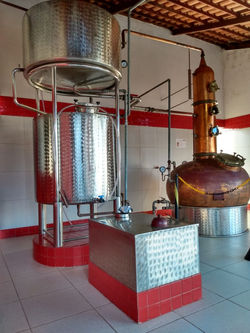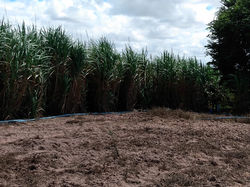
INNOVATIVE PRODUCTION WITH TRADITION
Of the many challenges to produce a quality cachaça, the three main ones are: the proper destination of the residues , given its polluting power in the soil, but that when treated turn into benefits; the reuse of water , given its high consumption; and the application of new techniques and knowledge, keeping the experiences of tradition.
In all stages of the production of SAN VALLE cachaça, the VALE VERDE mill faces these challenges by creating and adopting innovative systems and integration circuits for these stages, aiming at quality, preservation, sustainability and balance between the company and the environment.
Waste Circuit
All waste generated is reused sustainably
Water Circuit
Mineral water is available on the ground of the VALE VERDE mill, which contributes to the quality of the SAN VALLE cachaça
Temperature control
Challenge
It should be clarified that fermentation is a natural process for transforming sugar into alcohol, by yeasts whose optimization takes place at temperatures from 28 to 32°C. This is exactly the interval in which the ambient temperature of the ever GREEN VALLEY of Ceará Mirim is maintained. It would be a happy coincidence were it not for the release of heat by the yeasts, heating the wort, affecting the performance of the yeasts themselves, and enabling the performance of invading bacteria. The natural control of this heating requires immense water consumption. Artificial control is costly and not always effective. But this control is essential for the quality of cachaça.
Cooling tower
1st Curcuit of Waters
To solve the challenge, Agroindústria VALE VERDE created and carried out an innovative and important technical action that results in cost reduction and a great environmental benefit: the rational use of drinking water without giving up natural control. Even more because this water is mineral and from its own subsoil.
As the local ambient temperature is enough for a good fermentation, it only needed to bring this temperature into the wort when heated. Also being the site with abundant winds, a water cooling tower cascaded over an impermeable reservoir was created.
Large coils with vertical spirals were adapted in the fermentation vats, which are cylindrical and also vertical, built for this purpose. The water leaves this reservoir by pumping, at ambient temperature, passes through the coil where it exchanges heat with the heated wort and returns to the reservoir through the cascade of the tower, where it returns to ambient temperature naturally, given the abundant local winds, becoming again able to cool the wort when in the fermentation stage.
Control of the still condenser
2nd Water Circuit
The condenser needs a huge amount of water to cool and condense the still vapors. The solution was to apply the same system used in fermentation. An adaptation was made in the condenser so that the water, instead of passing through gravity, coming from an elevated box and going to disposal, goes through pumping, returning to the reservoir through the cooling tower and returning to room temperature, becoming again able to cool the distillation vapors are much more efficient since the pumping speed is much higher than gravity.
Boiler Control
3rd Water Circuit
Boiler steam also needs a lot of water. Another water reuse system is adopted. The result of the application of these systems was even better than expected in terms of efficiency and temperature control because, as the speed of the water pumped is greater than that of gravity, it cools faster, and all naturally, thanks to the compatibility of the ambient temperature of the local.
The cachaça produced at the beginning (head) and end (slurry) of the distillation, by-products that would be discarded, are redistilled with 70% alcohol and used for other purposes such as the necessary asepsis of the plant's equipment, especially those of milling and fermentation and filling rooms, constituting a reduction in costs, as it replaces alcohol 70, which has a high market value.
Irrigation
4th Water Circuit
The drip irrigation system is adopted in most of the sugarcane fields. A new system in sugar cane that is working. Even with a much lower water consumption, the first experiences point to greater productivity, greater efficiency, since the water goes straight to the root of the sugarcane, and doubling the sugarcane field's useful life from 6 to 12 years.
 CoolingColling Tower |  BarrelsCooling in Barrels |  CondenserStill condenser |
|---|---|---|
 Coolling pipesCoolling pipes |  IrrigationDripping irrigation |
